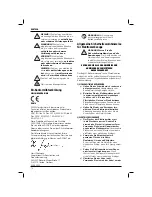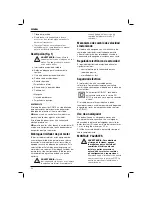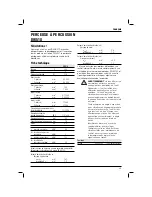
ENGLISH
26
Electronic Speed Control
The electronic speed control offers the following
advantages:
–
optimal tool control for accurate drilling
–
easier screwdriving
Electrical Safety
The electric motor has been designed for one
voltage only. Always check that the power supply
corresponds to the voltage on the rating plate.
Your D
E
WALT tool is double insulated in
accordance with EN 60745; therefore no
earth wire is required.
WARNING:
115 V units have to
be operated via a fail-safe isolating
transformer with an earth screen
between the primary and secondary
winding.
If the supply cord is damaged, it must be replaced
by a specially prepared cord available through the
D
E
WALT service organization.
Mains Plug Replacement
(U.K. & Ireland Only)
If a new mains plug needs to be fitted:
• Safely dispose of the old plug.
• Connect the brown lead to the live terminal in
the plug.
• Connect the blue lead to the neutral terminal.
WARNING:
No connection is to be
made to the earth terminal.
Follow the fitting instructions supplied with good
quality plugs. Recommended fuse: 13 A.
Using an Extension Cable
An extension cord should not be used unless
absolutely necessary. Use an approved extension
cable suitable for the power input of your charger
(see technical data). The minimum conductor size is
1 mm
2
; the maximum length is 30 m.
When using a cable reel, always unwind the cable
completely.
ASSEMBLY AND ADJUSTMENTS
WARNING: To reduce the risk of
injury, turn unit off and disconnect
machine from power source before
installing and removing accessories,
before adjusting or changing set-
ups or when making repairs
. Be sure
the trigger switch is in the OFF position.
An accidental start-up can cause injury.
Selecting the Operating Mode (fi g. 2)
The tool can be used in two operating modes:
Rotary drilling: for steel, wood and
plastics.
Percussion drilling: simultaneous rotating
and impacting for concrete and masonry
drilling operations.
Select the required operating mode by rotating the
mode selector (e) to the required position.
Inserting and Removing a Bit (fi g. 1)
KEYED CHUCK
1.
Open the chuck by turning the sleeve (i)
counterclockwise and insert the bit shank.
2.
Put the chuck key (j) into each hole in the side
of the chuck and turn clockwise until tight.
KEYLESS CHUCK
1.
Open the chuck by turning the sleeve
counterclockwise and insert the bit shank.
2.
Tighten firmly by turning the sleeve clockwise.
3.
To remove the bit, proceed in reverse order.
Fitting the Side Handle (fi g. 1)
The side handle (f) can be fitted to suit both
RH- and LH-users.
WARNING:
Always use the tool with
the side handle properly assembled.
1. L
oosen the side handle.
–
For RH-users, slide the side handle clamp
over the 43 mm collar behind the chuck,
handle at the left.
–
For LH-users, slide the side handle clamp
over the 43 mm collar behind the chuck,
handle at the right.
2.
Rotate the side handle to the desired position
and tighten the handle.
Setting the Drilling Depth (fi g. 3)
1.
Insert the required drill bit into the chuck.
2.
Slacken the side handle (f).
3.
Fit the depth adjustment rod (g) through the
hole in the side handle clamp.
4.
Adjust the drilling depth as shown.
5.
Tighten the side handle.
Summary of Contents for DW518
Page 1: ...DW518 www eu ...
Page 3: ...1 a i h g f e d c b j l k h Figure 1 ...
Page 4: ...2 e f g Figure 2 Figure 3 ...
Page 5: ...3 c d m Figure 4 Figure 5 Figure 6 Figure 7 ...
Page 6: ...4 Figure 8 ...
















































